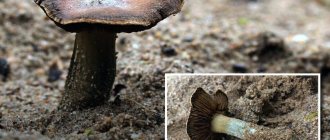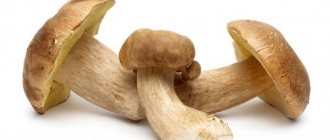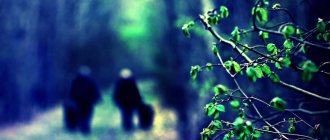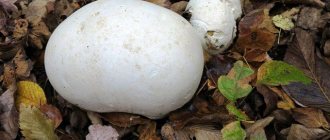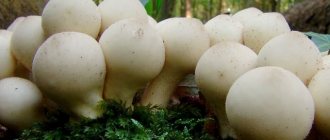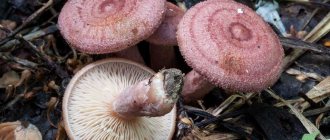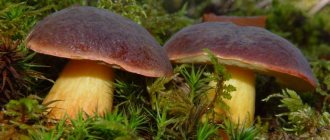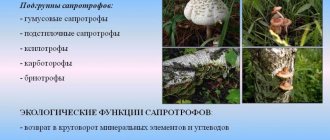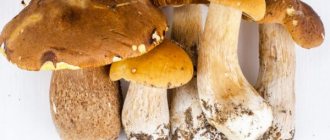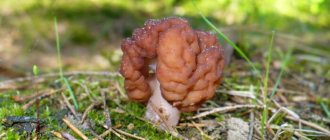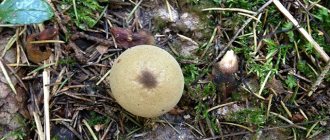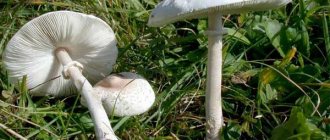Stropharia blue-green or Troischling verdigris is exactly the mushroom that you will certainly pay attention to if you come across it in the forest thicket. What is remarkable about this representative of the forest kingdom? It stands out in everything, from its unique shape to its completely unnatural color for mushrooms. Is it worth collecting this mushroom? Or just pass by, only from afar enjoying the unusualness of this representative of the Stropharia species? We will talk about this in this article.
Description and photo of blue-green stropharia
Let's start with the fact that blue-green stropharia belongs to the basidiomycete department. Subsection Agaricomycetes. Subclass agaricaceae. The order is agaric or lamellar. Family Strophariaceae.
This mushroom really amazes the imagination, as it is unlike any other. This is a very small mushroom, which in its feeding method is very similar to champignons.
From Latin - stropharia aeruginosa .
But it’s worth talking in more detail about its appearance, dividing the description into several parts.
hat
The cap of this mushroom can vary from 3 to 12 cm, depending on the soils on which it grows, as well as what it feeds on. In addition, the age of the mushroom also affects its size.
It has a wide canonical shape, but its shade is completely unnatural for mushrooms, greenish, and the color turns into an azure or blue tint. Rich green colors are less common.
It is noteworthy that its cap should be very abundantly covered with mucus, which dries over time in the form of yellow and white spots.
Along the edges of this mushroom there are small white growths, like the remains of a cobweb. If you look under the cap, you will see gray-green plates that are pressed very tightly together. They also have a lilac-brown tint if the mushroom grows in alkaline soils.
The smell of the cap is very interesting and resembles buckwheat. If you touch the cap, at a young age it feels quite dense and elastic to the touch, but in adulthood it resembles a very loose substance.
Leg
The leg deserves special attention. In girth it can reach a maximum of about 2 cm, but in length it varies from 5 to 10 cm. If you touch it, it seems that it is hollow, however, if it grows in acidic and rich soil, it becomes harder.
Connects to the cap very tightly. Also, on the leg you can see a kind of ring-shaped skirt, which initially has a blue tint, but with age it becomes dark brown.
Also, over time, the leg begins to subdivide into fibers, and then white inclusions begin to spread along it. This indicates that the mushroom is already quite mature.
Habitat
As for its habitat, this mushroom loves soils rich in alkali or acid. Therefore, it settles where there are rotting pieces of wood, as well as swamps and moisture. Mushrooms can be easily seen on roadsides, as well as along the banks of swamps. It can often be found in parks and gardens, where there is some humidity.
The fungus is very fond of rot, so it can easily be found near pastures, as well as in landfills. Most often, such forest inhabitants grow in groups, however, they are also quite often found alone.
Might be interesting - Green Mosquito Mushroom (Xerocomus Subtomentosus): photo and description.
Mushroom Stropharia sky blue: what is this miracle of nature?
Sky blue stropharia is a rather peculiar and unusual mushroom with a special color. It is rarely found in our forests, groves, and valleys, and not every lover of forest gifts knows it. At first glance, it seems poisonous and dangerous, but let's figure it out, is this true or not?
Description of the mushroom
Sky blue stropharia (Latin name Stropharia aeruginosa) is a bizarre mushroom of the strophariaceae family, which has an unusual and bewitching appearance.
Another name for this fruiting body is stropharia brown-spore. It has a cute bluish and greenish colored hat.
It is found in Russia in fairly large quantities; it can also be found in North America, Kazakhstan, and other European countries.
This type of mushroom grows alone or in small groups. It usually grows in parks, along the edges of paths, in various pastures; it develops especially well in humid conditions at temperatures not lower than 8–10 degrees. It bears more fruit from August to November.
It grows in mixed and coniferous forests, loves soil rich in humus, which contains many useful nutrients. It also grows very well in moist soils. The color of stropharia is blue-green; there are also ocher spots.
This mushroom is an edible species, but is not valued by connoisseurs at all and is not eaten in other countries.
Hymenophore
The hymenophore is the part of the fruiting body that bears on the surface a thin layer of spores called the hymenium. In simple terms, this is the bottom part of the cap.
Often the surface of the hymenophore is well developed, this allows the fungus to create a larger number of spores.
The hymenophore is plate-shaped, the plates are adherent to the stalk, often located, bluish at a young age, and violet when ripe.
Pulp on the cut
When cut, the pulp has a rather soft structure, the color is similar to dirty white, there is also the presence of a green or blue tint, which is also quite normal. Taste and smell are not pronounced.
Controversy
The spores are very small and usually brown in color. Spore powder is dark lilac.
Time and place of fruiting
Stropharia bears fruit most from July to October, grows and develops well in humid conditions at temperatures not lower than 8-10 degrees. Loves wet and rainy weather.
False doubles
One of the mushrooms similar to stropharia sky blue is blue-green. There is only one significant difference between them - the sky blue one has a darker cap color.
Also, it grows not in parks, but in forests, the flesh can turn noticeably yellow when it comes into contact with the environment, and their stem is not so large. It, like the sky blue stropharia, is an edible mushroom, but when properly prepared and consumed in moderation.
It is interesting that the safety of these mushrooms has been proven only in Russia and the CIS countries, and in other countries they are not allowed for food consumption.
Taste assessment and preparation
Sky blue stropharia is conventionally classified as an edible mushroom.
They say that it has a hallucinogenic property, but it is quite mild, and if a person just tries the mushroom, then absolutely nothing will happen to him.
Sky blue stropharia is prepared in the same way as other species. To begin with, it must be cooked for forty minutes. After cooking, it should be salted, marinated, fried and finally stewed.
Attention! Before cooking, it is recommended to remove the skin (simply peel it off) from the mushroom cap, since it has a not very pleasant mucous structure, which may not be to everyone’s taste, although many people eat it with pleasure.
Interesting facts about the mushroom
- Only in Russia and the CIS countries is sky blue stropharia considered an edible mushroom; in the USA and many other countries the species is considered poisonous and is not eaten.
- Unfortunately, excessive consumption of stropharia and overeating threatens with visual hallucinations and nervous excitement for a period of up to two hours.
- One of the most interesting facts: the hallucinogenic property of this mushroom is so weak that for its appearance you need to eat about one kilogram of fruiting bodies raw.
Sky blue stropharia is not of particular interest to mushroom pickers; most often they collect it out of interest or simply by chance discovery. There is no particularly pronounced taste. As an option, you can cook stropharia with other mushrooms, for example, pickle them or combine them with each other.
This species is not poisonous, is common in Russia, and has a very interesting coloring, which often attracts mushroom pickers, as well as forest animals.
Source: https://gribnik.info/strofaria-nebesno-sinaa/
Similar species
Of course, stropharia is far from the only mushroom that has such a specific appearance.
It has several similar brothers that are almost identical to it.
Stropharia sky blue
Stropharia sky blue is a unique mushroom that affects from the very beginning, as soon as it hits your field of vision. Its main specificity is that it has a matte blue tint, on which noticeable spots of ocher appear. Also, this mushroom may also contain green shades. The pulp is off-white in color and, when exposed to oxygen, also acquires a blue tint.
The leg has the shape of a regular cylinder, and is also framed by a large ring.
This mushroom is a real work of art, as it has an attractive appearance. The blue color is so unnatural that it seems like paint was applied to this mushroom. However, this specificity is manifested in the type of pigment that is contained in the mushroom.
Stropharia crown
Stropharia crown is a mushroom that is also called stropharia red. Despite the fact that the color of the cap has a warm undertone, it is still very similar to blue-green, since due to the lack of necessary substances, the cap begins to take on a different character. In the dark in a dense forest, it is very difficult to make out which mushroom is in front of you.
The color of this cap is variable, sometimes turning gray.
There is conflicting information about the edibility of this mushroom, so its consumption can lead to poisoning of the body.
Troischling verdigris is on Wikipedia.
Recipes
Despite the fact that blue-green stropharia is a rather rare mushroom, you can still find recipes that offer delicious preparation of this forest dweller. Find out how to properly prepare blue-green stropharia.
However, remember that the mushroom must be properly prepared first. This is necessary in order not to harm your body.
How does the preparation take place?
- At the initial stage, all debris must be removed from the mushroom. To do this, insects, leaves, branches, needles, and other foreign objects are removed.
- Rinse under running water.
- Then fill a container with water and leave the mushrooms in it for a couple of hours to soak.
- The water is drained.
- Add some more water to the pan and put it on the fire.
- As soon as the water boils, you can add mushrooms to it. They must boil for at least 5 minutes.
Now stropharia can be used to prepare various dishes.
Pickling
In the case of strafaria, you can resort to the most common methods of pickling mushrooms. Despite its specific appearance, stropharia is very tasty and enjoyable.
However, it is recommended to carry out salting using the cold method. It will help preserve all its specific properties. Prepare the mushroom as described above.
However, it is recommended to cook stropharia in salted water. The solution should be made with approximately 10 g of salt and 2 g of citric acid per liter of water.
After the mushroom has been soaked, you must first sprinkle it with dry salt and distribute the spices well over the mushrooms. Then, put it in a similar state in a jar.
Carry out salting so that for about 1 kg of mushrooms you need about 50 g of salt.
Place peeled garlic, bay leaf, and black peppercorns on the bottom of the jar.
Then, water is poured into the bowl so that it covers all the mushrooms. However, they leave a space of about how many centimeters. This is done so that the mushrooms fill the remains in the jar to the top.
Salted mushrooms are put in a cold place.
Pickling
To marinate mushrooms, you need to use a different method.
- So, you will need to soak the mushrooms.
- Then they are boiled in boiling water for 10 minutes.
- While the mushrooms are drying, prepare the pickling solution.
- Pour 900 ml of water into the pan.
- Add 10 g salt.
- 3 g citric acid.
- One teaspoon of sugar.
- Bring to a boil.
- Remove from heat.
- Add 3 peppercorns and dill seeds to the solution.
- Peeled garlic cloves are placed at the bottom of the jar. Also, a couple of bay leaves.
- Mushrooms are packed tightly into the jar. The top is filled with coolant.
It is also recommended to store in a cool place.
Hallucinogenicity
Despite the fact that this mushroom is not considered poisonous, some people note that it has certain hallucinogenic properties. This is true.
Mushrooms that grow in strong alkaline soils contain meconic acid. This is one of the most important components that is included in the composition.
Unfortunately, some representatives of this family of mushrooms have quite a large amount of the substance, especially during the season when the weather is hot.
Therefore, if you consume a significant amount of such mushrooms, you can achieve an intoxication effect. This means that people may well be susceptible to hallucinations. Therefore, it is not recommended to eat mushrooms that have not undergone appropriate heat treatment.
Unfortunately, you may have a special type of syndrome that not only causes severe visual hallucinations, but also auditory ones. A person can remain in this state for up to 4 hours.
Blue-green stropharia is a real decoration of the forest. It has an attractive appearance, and that is why it is almost impossible to pass by it.
However, her specific appearance not only attracts, but also repels. Therefore, many inexperienced mushroom pickers believe that this mushroom is truly poisonous, which means they try not to collect it in their basket. In fact, this is not correct.
If you're not sure, don't take it!
Blue-green stropharia is a completely edible mushroom that can be used as food, at least to have an idea of what kind of mushroom is in front of you. If you meet it in the forest, do not be alarmed, but simply collect it in a basket and bring it home. Surely, a delicious dinner will await you, which will bring many new taste experiences into your life. After all, as they say, blue-green stropharia has a spicy, pleasant taste that does not leave you indifferent.
Edibility
In Europe, blue-green stropharia is not valued as an object of collection: its taste is considered low. In America, these mushrooms are classified as poisonous. In general, after the cuticle of the cap is removed and the mushrooms undergo long-term heat treatment, they do not pose a threat to health and can be used for pickling and pickling. When consuming raw or incompletely boiled mushrooms grown under certain conditions, intoxication occurs due to the action of a hallucinogen.
